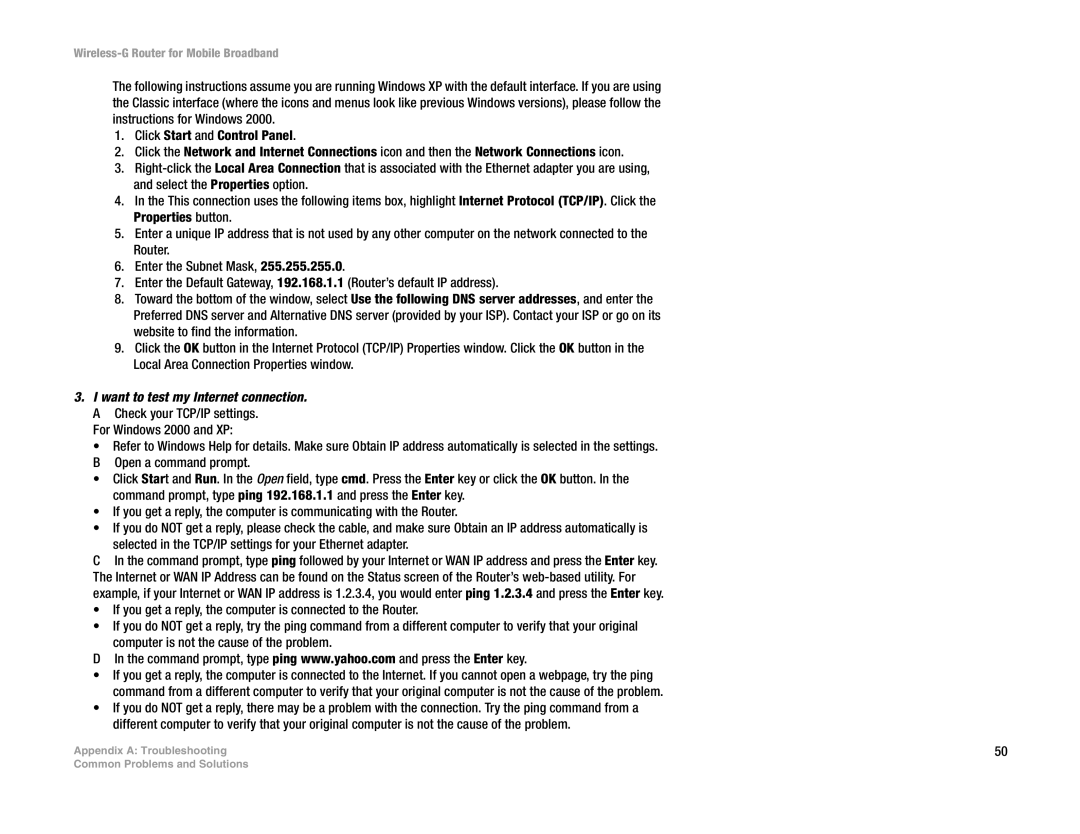Wireless-G Router for Mobile Broadband
The following instructions assume you are running Windows XP with the default interface. If you are using the Classic interface (where the icons and menus look like previous Windows versions), please follow the instructions for Windows 2000.
1.Click Start and Control Panel.
2.Click the Network and Internet Connections icon and then the Network Connections icon.
3.
4.In the This connection uses the following items box, highlight Internet Protocol (TCP/IP). Click the Properties button.
5.Enter a unique IP address that is not used by any other computer on the network connected to the Router.
6.Enter the Subnet Mask, 255.255.255.0.
7.Enter the Default Gateway, 192.168.1.1 (Router’s default IP address).
8.Toward the bottom of the window, select Use the following DNS server addresses, and enter the Preferred DNS server and Alternative DNS server (provided by your ISP). Contact your ISP or go on its website to find the information.
9.Click the OK button in the Internet Protocol (TCP/IP) Properties window. Click the OK button in the Local Area Connection Properties window.
3.I want to test my Internet connection. A Check your TCP/IP settings.
For Windows 2000 and XP:
•Refer to Windows Help for details. Make sure Obtain IP address automatically is selected in the settings. B Open a command prompt.
•Click Start and Run. In the Open field, type cmd. Press the Enter key or click the OK button. In the command prompt, type ping 192.168.1.1 and press the Enter key.
•If you get a reply, the computer is communicating with the Router.
•If you do NOT get a reply, please check the cable, and make sure Obtain an IP address automatically is selected in the TCP/IP settings for your Ethernet adapter.
CIn the command prompt, type ping followed by your Internet or WAN IP address and press the Enter key. The Internet or WAN IP Address can be found on the Status screen of the Router’s
• If you get a reply, the computer is connected to the Router.
• If you do NOT get a reply, try the ping command from a different computer to verify that your original computer is not the cause of the problem.
DIn the command prompt, type ping www.yahoo.com and press the Enter key.
•If you get a reply, the computer is connected to the Internet. If you cannot open a webpage, try the ping command from a different computer to verify that your original computer is not the cause of the problem.
•If you do NOT get a reply, there may be a problem with the connection. Try the ping command from a different computer to verify that your original computer is not the cause of the problem.
Appendix A: Troubleshooting | 50 |
Common Problems and Solutions
